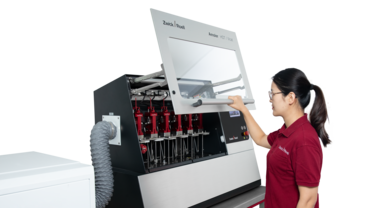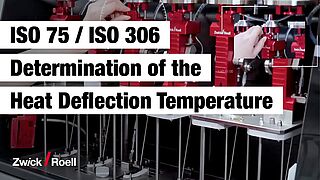ISO 2507 Determination of Vicat Softening Temperature for Plastic Pipes
ISO 2507 describes the test method and test conditions for determining the Vicat softening temperature of thermoplastic pipes and fittings.
ISO 2507-1 specifies the general test method, ISO 2507-2 describes the test conditions for pipes and fittings made of unplasticized polyvinyl chloride (PVC-U) or chlorinated polyvinyl chloride (PVC-C) (PVC-C) and for pipes made of high-impact polyvinyl chloride (PVC-HI). ISO 2507-3 defines the test conditions for pipes and fittings made of acrylonitrile/butadiene/styrene (ABS) and acrylonitrile/styrene/acrylic ester (ASA).
ISO 2507-1 is based on ISO 306 - Vicat softening temperature of thermoplastics in sheet form. Compared to ISO 306, it includes adaptation of method B using a load of 50 N.
ISO 2507 parts 1 to 3 replace the EN 727 standard.
Objective & applications Running a test Vicat tester Request a consultation
Objective of the VST test in accordance with ISO 2507
The determination of the Vicat softening temperature according to ISO 2507 is used to characterize a thermoplastic pipe material with regard to its thermal behavior. Accordingly, the test is applied if the eventual use of a pipe is intended for elevated temperatures.
The VST measurement value does not represent a physical quantity, but serves as a comparative value for testing and classifying materials under the same test conditions.
Running a test and test equipment in accordance with ISO 2507
- The Vicat softening temperature indicates the temperature at which a circular indenter with a cross-section of 1 mm² under a standard load of 10 N or 50 N will penetrate the specimen precisely 1 mm deep. The Vicat softening temperature is defined in ISO 306 and ASTM D1525.
- Classic Vicat testers work with a silicone oil as the heat transfer fluid. This is the most cost-effective method, which can be carried out accurately and precisely. In addition, processes have been established that work with air or other media for heat transfer, but often tend to provide less accurate values and greater value variation. ISO 306 offers a reliable method with direct contact heat transfer from the metal surfaces to the specimen. This oil-free method is particularly suitable if odor pollution from heated oil is a problem and the VST test must be carried out on a regular basis.
Vicat tester according to ISO 2507 testing of plastic pipes
Depending on the frequency of the measurements and according to the time available in between, which is used for re-cooling of the heat-transfer fluid, different instrument versions are available. This ranges from relatively simple, manually operated instruments to instruments that support a largely automatic test sequence. Higher quality instruments are equipped with electrically interlocking protective covers and the option of integrated fume extraction, which provide additional convenience and safety for the operator.
ZwickRoell's testing solution, the Amsler Allround 6-300 heat deflection tester, is a closed instrument for determining Vicat and HDT temperatures up to 300 °C in accordance with all ISO and ASTM standards. Accurate and repeatable results are achieved through the use of advanced displacement measurement and temperature control technology. A user-friendly, safety-oriented and uncompromising design ensures comfort and safety. Either 2, 4 or 6 test stations with automated start of the cooling process, motorized lowering of the specimen and load application can be provided. The heat deflection tester can be operated in standalone mode with touch display or in connection with a PC. With the testXpert testing software, a meaningful analysis of the results can be realized.
More about the heat deflection tester More about the testXpert testing software


